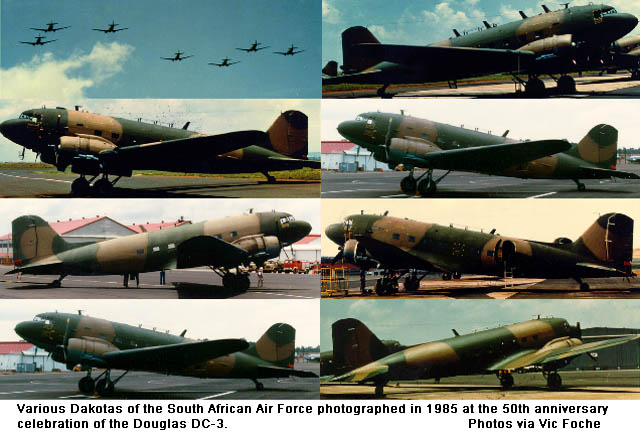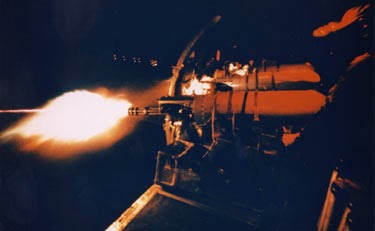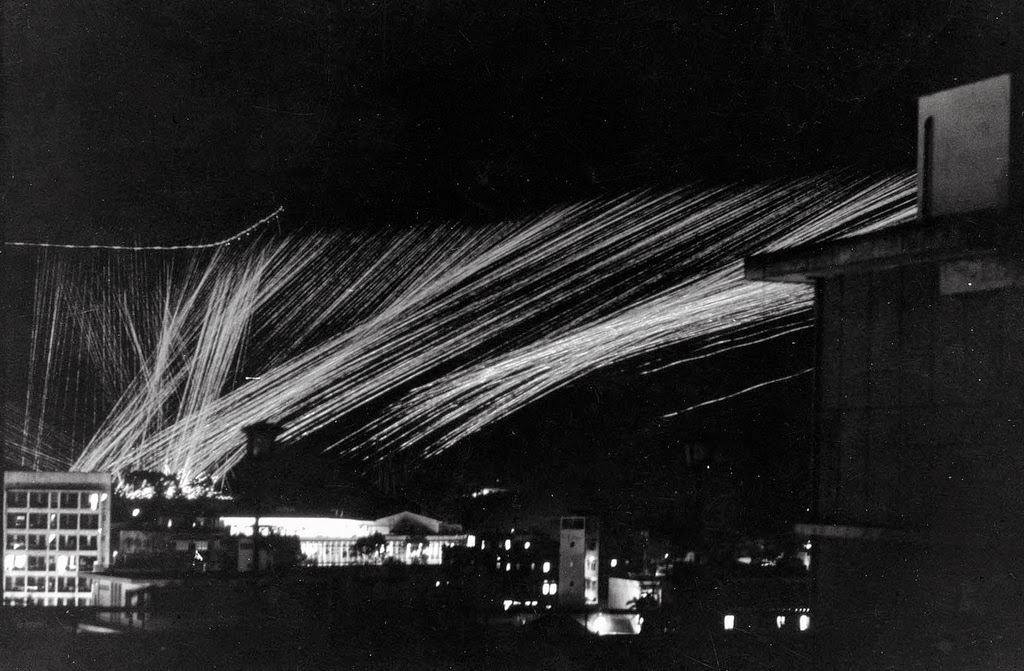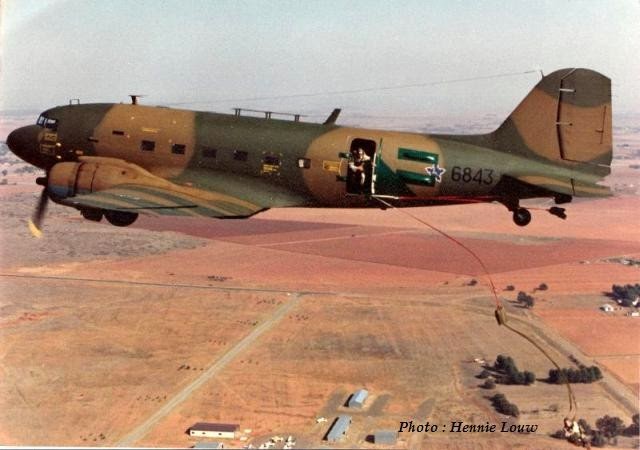Dakota Part 5:
Douglas AC-47 Spooky / Puff, the Magic Dragon / Dragon Dak
The Douglas AC-47 Spooky (also nicknamed "Puff, the Magic Dragon") was the first in a series of gunships developed by the United States Air Force during the Vietnam War. More firepower than could be provided by light and medium ground-attack aircraft was thought to be needed in some situations when ground forces called for close air support.
British "Waist-gunners" using Lewis Guns in WW2,
mostly for anti-aircraft purposes rather than ground attack
Late in World War II, an Army Air Force lieutenant named Gilmour C. MacDonald had come up with the idea of mounting side-firing weapons in aircraft for the ground attack mission. The pilot of a conventional attack aircraft had to make a pass on a target and fire his weapons, then come around for another pass. The pilot of an attack aircraft with side-firing weapons could simply perform a banking "pylon turn" around a target, line up the target along his wingtip, and then hose it down with a "cone of fire" for as long as ammunition held out.
Nothing came of the idea until 1961, when MacDonald, by then a USAF lieutenant colonel, brought it up again and managed to inspire a set of shoestring demonstrations of the concept. By 1964, it was the right idea in the right place. The USAF was trying to come to grips with the difficulties of fighting the growing jungle war in Southeast Asia, in particular casting about for a way to perform effective close air support for ground operations.
In August of that year, the war had undergone a drastic escalation with the the Tonkin Gulf incident. In November, a USAF captain named Ronald W. Terry sold the idea of a gunship to the brass, and was authorized to put together two gunships quickly for a combat evaluation. MacDonald was the father of the idea of the side-firing gunship, but Terry was the one who would make it work.
The initial two Dakota gunships were in Vietnam by December and in combat before the end of the year. The gunships were originally given the designation of "FC-47D", but this was quickly changed to "AC-47D" in response to loud complaints by fighter pilots that calling any kind of a C-47 a "fighter" was really stretching the definition of the term.
The AC-47Ds was fitted with three 7.62 millimeter (0.30 caliber) Gatling-style Miniguns firing out the left side of the aircraft. The Miniguns had a selectable rate of fire of 3,000 or 6,000 rounds per minute, and the gunship typically carried about 24,000 rounds of ammunition. Early gunships used improvised cargo-hold mounts for standard SUU-11A/A Minigun pods, the pod having been designed as an underwing store. Later gunships carried GAU-2B/A Miniguns more specifically rigged for the task, and then the far more satisfactory MXU-470/A Miniguns, which used an ammunition drum instead of a belt-feed from ammunition cans, with great improvement in convenience and reliability. After some experience, the guns would be fixed pointing 12 degrees downward, reducing the aircraft bank angle required for attacks.
Electrically operated miniguns
Ballistic armor curtains were fitted to the left side of the aircraft to protect crew and systems; new radio and navigation equipment were installed; a Mark 20 gun sight salvaged from the Douglas A-1 Skyraider attack aircraft was fitted to the cockpit left-side window; and a trigger button from the same source was attached to the pilot's control wheel. The AC-47Ds also carried a bin of illumination flares for night fighting next to the cargo door, with the flares tossed out of the aircraft by the flight crew by hand. The bin was later armored to prevent the flares from being set off by ground fire.
Vietnamese who observed attacks by the gunships compared them to roaring, fire-spouting dragons, and so the gunships acquired the name "Puff", after a contemporary pop tune, "Puff the Magic Dragon". They were more informally called "Spooky" after their radio call-sign, and were well-liked by US ground forces for their ability to literally rip enemy assaults to shreds.
Spent casings after a Vietnam mission
The AC-47 initially used SUU-11/A gun pods that were installed on locally fabricated mounts for the gunship application. Emerson Electric eventually developed the MXU-470/A to replace the gun pods, which were also used on subsequent gunships.
Miniguns at the ready
Flare canister
In August 1964, years of fixed-wing gunship experimentation reached a new peak with Project Tailchaser under the direction of Capt. John C. Simons. This test involved the conversion of a single Convair C-131B to be capable of firing a single GAU-2/A Minigun at a downward angle out of the left side of the aircraft. Even crude grease pencil crosshairs were quickly discovered to enable a pilot flying in a pylon turn to hit a stationary area target with relative accuracy and ease. The Armament Development and Test Center tested the craft at Eglin Air Force Base, Florida, but lack of funding soon suspended the tests. In 1964, Capt. Ron W. Terry returned from temporary duty in Vietnam as part of an Air Force Systems Command team reviewing all aspects of air operations in counter-insurgency warfare, where he had noted the usefulness of C-47s and C-123s orbiting as flare ships during night attacks on fortified hamlets. He received permission to conduct a live-fire test using the C-131 and revived the side-firing gunship program.
Minigun in action
By October, Capt. Terry's team under Project Gunship provided a C-47D, which was converted to a similar standard as the Project Tailchaser aircraft and armed with three miniguns, which were initially mounted on locally fabricated mounts—essentially strapped gun pods intended for fixed-wing aircraft (SUU-11/A) onto a mount allowing them to be fired remotely out the port side. Captain Terry and a testing team arrived at Bien Hoa Air Base, South Vietnam, on 2 December 1964, with equipment needed to modify two C-47s. The first test aircraft (43-48579, a C-47B-5-DK mail courier converted to C-47D standard by removal of its superchargers) was ready by 11 December, the second by 15 December, and both were allocated to the 1st Air Commando Squadron for combat testing. The newly dubbed "FC-47" often operated under the radio call sign "Puff". Its primary mission involved protecting villages, hamlets, and personnel from mass attacks by VC guerrilla units.
Spooky in Vietnam
Twin Browning arrangement
Gatling Minigun replacement
Spooky inbound
The 4th ACS deployed to Tan Son Nhut Air Base, Vietnam, on 14 November 1965. Now using the call sign "Spooky", each of its three 7.62 mm miniguns could selectively fire either 50 or 100 rounds per second. It can be seen in action here. Cruising in an overhead left-hand orbit at 120 knots air speed at an altitude of 3,000 ft, the gunship could put a bullet or glowing red tracer (every fifth round) bullet into every square yard of a football field-sized target in potentially less than 10 seconds.[dubious – discuss] And, as long as its 45-flare and 24,000-round basic load of ammunition held out, it could do this intermittently while loitering over the target for hours.
On the ground with an early model Hercules C130 A (note the short nose)
One of the most publicized battles of the Vietnam War was the siege of Khe Sanh in early 1968, known as "Operation Niagara". More than 24,000 tactical and 2700 B-52 strikes dropped 110,000 tons of ordnance in attacks that averaged over 300 sorties per day. During the two and a half months of combat in that tiny area, fighters were in the air day and night. At night, AC-47 gunships kept up a constant chatter of fire against enemy troops. During darkness, AC-47 gunships provided illumination against enemy troops.
Gunships pouring fire onto the enemy
An open shutter shows how an eliptical fly path allowed massive fire-power
to be unleashed on a relatively small (ca 50 sq metre target)
A1C John L. Levitow, an AC-47 loadmaster with the 3rd SOS, received the Medal of Honor for saving his aircraft, Spooky 71, from destruction on 24 February 1969 during a fire support mission at Long Binh. The aircraft was struck by an 82-mm mortar round that inflicted 3,500 shrapnel holes, wounding Levitow 40 times, but he used his body to jettison an armed magnesium flare, which ignited shortly after Levitow ejected it from the aircraft, allowing the AC-47 to return to base.
Demand for the Spooky was so high that availability of Miniguns became a problem, so four of the AC-47Ds were put together using a stockpile of old Browning 7.62 millimeter (0.30 caliber) machine guns found in a warehouse in California, with each aircraft carrying ten side-firing machine guns each.
About 47 AC-47Ds were produced, with 12 lost in combat, particularly as enemy air defenses improved. A more capable platform -- in particular equipped with sophisticated sensor system to permit it to perform "search and destroy" missions instead of simply performing fire support -- was obviously needed. The AC-47Ds were replaced by the Fairchild AC-119G Boxcar gunship, with an electronic sensor system, for fire support missions, with the search and destroy mission farmed out to the highly sophisticated and completely fearsome Lockheed AC-130A Hercules / Spectre gunship.
Other air forces
In 2006, Colombia started operating retrofitted AC-47s, where they are known by civilians as Avion Fantasma (ghost plane). They are successfully operated by the Colombian Air Force in counter-insurgency operations in conjunction with AH-60 Arpia helicopters (an armed variant of the UH-60) and Cessna A-37 Dragonflys against local illegally armed groups. These are five Basler BT-67s purchased by Colombia with .50 cal (12.7 mm) GAU-19/A machine guns slaved to a forward looking infrared (or FLIR) system. They also have the ability to carry bombs. At least one has been seen fitted with one GAU-19/A and a 20 mm cannon, most likely a French made M621. The BT-67 is a variant of the C-47/DC-3 modified by the Basler Corporation of Oshkosh, Wisconsin.
In 1970, the Indonesian Air Force converted a former civilian DC-3. The converted aircraft was armed with three .50 cal machine guns. During 1975, the Indonesian Air Force used its "AC-47" in the Indonesian invasion of East Timor to attack the city of Dili. Later, the aircraft was used in Indonesian military close air support missions in East Timor. A retirement date is unknown.
In December 1984 and January 1985, the United States supplied two AC-47D gunships to the El Salvador Air Force and trained aircrews to operate the system. The AC-47 gunship carried three .50 cal machine guns and could loiter and provide heavy firepower for army operations. As the FAS had long operated C-47s, it was easy for the United States to train pilots and crew to operate the aircraft as a weapons platform. By all accounts, the AC-47 soon became probably the most effective weapon in the FAS arsenal.
Variants of the AC-47 based on various iterations of the airframe including the BT-67, have been used by Laos, Cambodia, South Africa, El Salvador, and Rhodesia, to name just a few, and with a variety of weapons configurations including Gatling guns of numerous types, various medium and heavy machine guns, and larger auto cannon (South African "Dragon Daks" were known to fit 20 mm cannons). The Republic of China Air Force (Taiwanese Air Force) also converted some of its C-47s to gunships. These machines were armed with M2 machine guns.

.50 cal vs 20 mm rounds for comparison
South African Air Force "Dragon Daks"

The Dak was often used for Paratroop drops
SAAF Gunships mounted either 20mm cannon or HMGs
Different arrangements were tested:
John Vorster, later Prime Minister, inspecting a twin HMG system
The single 20mm gun
SA Dragon Dak Gunner in action

















.jpg)









Live and learn,i wish we had these "Birds" in Mozanbique,back in 1969/ 1974.I have to see your page very slowly.Thanks.
ReplyDeletewounderful AC
ReplyDeleteOne of the pictures posted is of my grandfather. If there is any way to reach out to you I would be very grateful.
ReplyDeleteAt least twice in Vietnam a Spooky gunship came to our rescue. I was a aeroscout in D Troop, 1/10 Cavalry stationed in Camp Enari the first time, in early '67 and, then again in An Khe, I believe sometime in March '70 the second time the Spooky ships lit up our sky. After half a century details are hazy but the river of tracers is still vivid. Trying to leave some memories for my kids and found your site. Terrific! Would like to copy some of this for my kids to see.
ReplyDeleteIt's possible that during March 1970, you may have had an AC-119G Shadow or AC-119K Stinger come to your rescue. During December 1969, all of the AC-47 Spooky gunships were turned over to the Southeast Asian Air Forces, including the VNAF. Shadow had four 7.62 miniguns where as Stinger had four 7.62 miniguns and two 20 mm gatling guns. Hard to tell the difference at night, they both sprayed fire and death from the sky. I was a crew chief on an AC-47 Spooky at Danang from Nov 1968 to Nov 1969. I was glad I wasn't there when my aircraft was given to the VNAF.
DeletePuff the Magic Dragon aka Spooky was sent to us from Eglin Air Force Base in Florida to test and deploy. I was in the Air Force Testing Unit under the Joint Research and Testing Activity head quartered on Hai Bai Trung Street in Saigon. We tested Puff and made recommendations for modifications and deployment. I am proud to say that I had a great part of Puff saving the lives of unknown number of Americans.
ReplyDelete